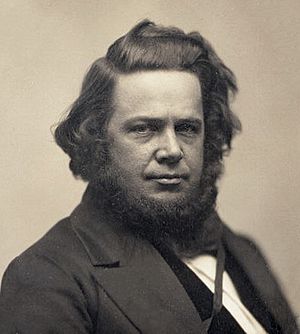Elias Howe facts for kids
Quick facts for kids
Elias Howe
|
|
|---|---|
 |
|
| Born |
Elias Howe Jr.
July 9, 1819 |
| Died | October 3, 1867 (aged 48) |
| Nationality | American |
| Education | apprenticed as mechanic and machinist |
| Occupation | Engineer |
| Spouse(s) | Elizabeth Jennings Ames (m. 1841; d. 1850) Rose Halladay (d. 1890) |
| Children | Jane Robinson Howe, Simon Ames Howe, Julia Maria Howe |
| Parent(s) | Elias Howe and Polly (Bemis) Howe |
| Engineering career | |
| Discipline | Mechanical Engineering |
| Projects | Sewing machine |
| Significant advance | Lockstitch loop method |
| Awards | Gold Medal, Paris Exposition of 1867, Légion d'honneur (France) |
Elias Howe Jr. (born July 9, 1819, died October 3, 1867) was an American inventor. He is most famous for creating the modern lockstitch sewing machine. His invention changed how clothes were made forever.
Contents
Elias Howe's Early Life
Elias Howe Jr. was born in Spencer, Massachusetts, on July 9, 1819. His parents were Elias Howe Sr. and Polly (Bemis) Howe. He grew up in Massachusetts.
In 1835, Elias started working in a textile factory in Lowell, Massachusetts. This is where fabrics are made. After some factories closed in 1837, he moved to Cambridge, Massachusetts. There, he worked as a mechanic. He fixed machines that prepared wool for spinning.
In 1838, he began working for Ari Davis. Davis was a skilled mechanic who repaired clocks and other precise tools. It was while working for Davis that Elias got the idea for the sewing machine.
He married Elizabeth Jennings Ames in 1841. They had three children together. Later, he married Rose Halladay.
Inventing the Sewing Machine
Elias Howe was not the first person to think of a sewing machine. Many others had tried before him. Some even made working machines. But Howe made important improvements to these earlier ideas.
On September 10, 1846, he received the first United States patent for a sewing machine. His machine used a special method called the lockstitch. This method is still used in most sewing machines today.
His machine had three key parts:
- A needle with the eye (hole) at its point.
- A shuttle that moved under the fabric to create the lockstitch.
- An automatic way to feed the fabric through the machine.
Challenges and Success
Even with his patent, Elias had trouble finding people in the United States to invest in his invention. So, his older brother, Amasa Bemis Howe, went to England in 1846. Amasa sold the first machine for £250 to William Thomas in London. Thomas owned a factory that made corsets and umbrellas.
Elias and his family moved to London in 1848. But he had disagreements with Thomas. Elias's wife also became ill. He returned to the United States almost broke in 1849. Sadly, his wife Elizabeth died shortly after his return.
Other inventors started making sewing machines. Elias had to go to court to protect his patent. This legal fight lasted from 1849 to 1854. He found that Isaac Singer was selling a machine very similar to his. Howe won the case. This meant he earned a lot of money from Singer and others who sold machines using his ideas. These payments were called royalties.
During the American Civil War, Elias Howe helped the Union Army. He used much of his money to buy equipment for a group of soldiers from Connecticut. He even served as a private in the army himself. He mostly did light duties because of his health. He also worked as the Regimental Postmaster.
Other Inventions and Legacy
In 1851, Elias Howe received another patent. This was for an "Automatic, Continuous Clothing Closure." This invention was actually an early version of the zipper! However, he did not try to sell it. He was too busy with his sewing machine business.
After 1854, Elias's older brother, Amasa, ran a factory in New York City. They made sewing machines under the name Howe Sewing Machine Co.. This company won a gold medal in London in 1862.
Between 1865 and 1867, Elias himself started The Howe Machine Co. in Connecticut. His sons-in-law ran this company. Elias Howe's sewing machine won another gold medal at the Paris Exhibition of 1867. That same year, he received the Légion d'honneur from France. This was a very high award for his invention.
Elias Howe died on October 3, 1867, at the age of 48. He was buried in Green-Wood Cemetery in Brooklyn, New York. Both Elias Howe and Isaac Singer became very wealthy from their sewing machine businesses.
Elias Howe was honored with a special 5-cent stamp in 1940. The 1965 Beatles movie Help! was even dedicated to his memory. In 2004, he was added to the United States National Inventors Hall of Fame.
Images for kids
See also
 In Spanish: Elias Howe para niños
In Spanish: Elias Howe para niños
- Daniel Davis Jr.



